ProAc DT8 (ProAc Response DT8)
The ProAc Response or just ProAc DT8 is a loudspeaker (3) designed with two bass/mid-range (4) units made of a different cone material (5): Polypropylene (6) (11) and Pulp Mica (12) (13). This is the first ProAc loudspeaker (7) to use these two different cone materials (8), making the sound extremely balanced (9) (10). The silk-made ProAc Dome tweeter is placed asymmetrically (2) between the two bass / mid units (1).
The new ProAc DT8 is a new speaker in the Proac catalog which is positioned between the Studio 148 and the Response D20.
We unboxed and installed the ProAc DT8 with the employees of El Corte Ingles in Madrid, to whom we would like to thank for their collaboration. They loved to test the device with us and provide us their impressions about it.
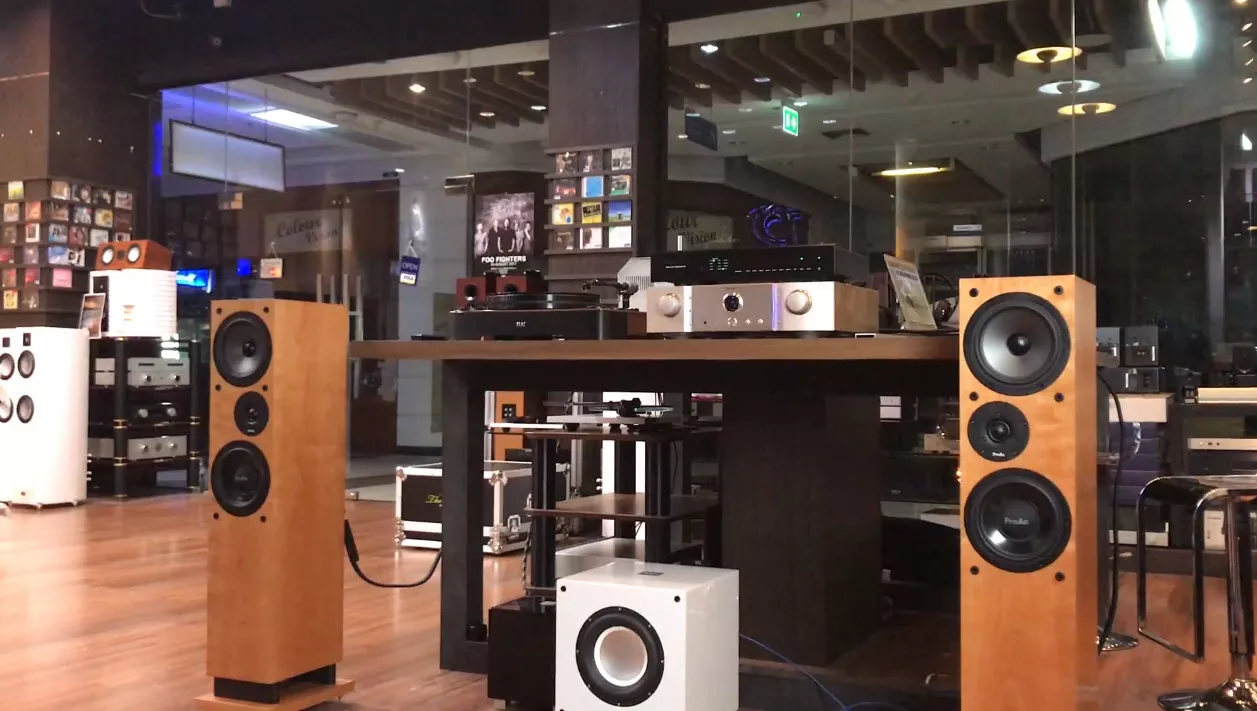
THE SETTING OF THE PROAC DT8 IN THE STORE. THANKS TO THE AUDIO DEPARTMENT OF EL CORTE INGLES IN MADRID DURING THE LAST PHASE OF THE QUARANTINE.
Aesthetically this ProAc DT8 resembles the size and presentation of a D20, but it innovates compared to its elders since it adopts a layout of its speakers in a configuration called D´Appolito (from the name of its designer Joseph D´Appolito): that is to say a tweeter in the middle of 2 bass speakers. This midwoofer-tweeter-midwoofer loudspeaker configuration is also called MTM, for short.
It, therefore, takes up the concept of the ProAc D48 and the newer ProAc K3 but the two bass drivers with a 16.5 cm diameter (6.5 inches) medium are different. One is made of a mica pulp membrane and the other is made of a polypropylene membrane. The yield is generous of 90 dB at 4 Ohms. These two woofers work in tandem and are specially filtered according to the differences in the composition of their membranes.
The ProAc DT8 speakers become the new entry-level columns from the famous English firm. Its discreet line, for our greatest satisfaction it integrates the high-end Response series.
The downward vent allows an easier arrangement in the listening room.
It replaces the Studio 148MK2, with a real desire to offer the musical performances of the Response series.
The particularity of these components and filtering loudspeakers could therefore well be at the origin of the particularly remarkable characteristics when listening to the frequency registers that they use.
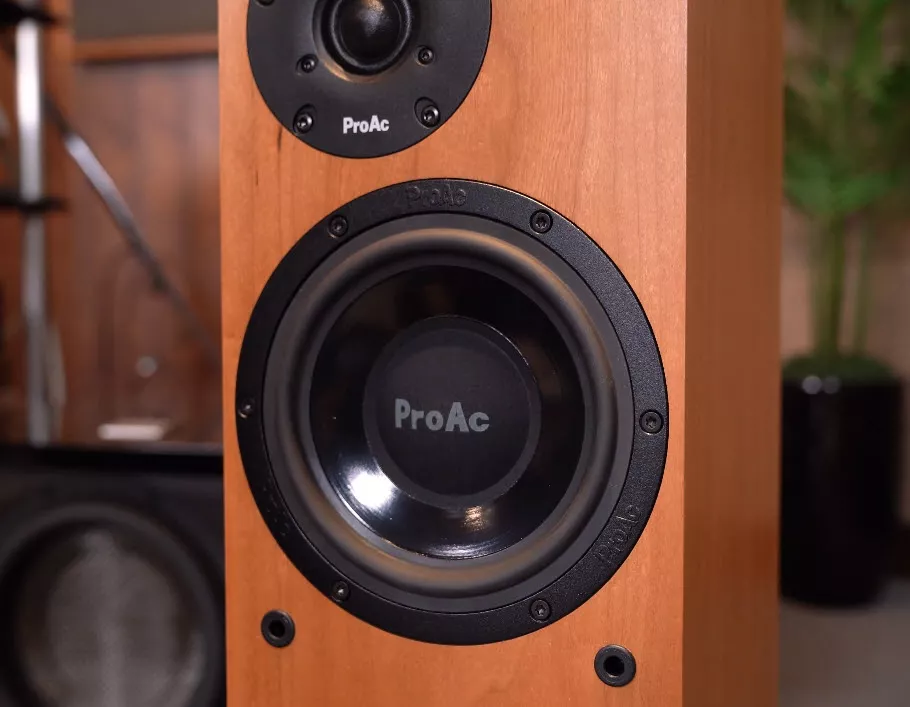
If the general sweetness is distinguished from the more invigorating and outgoing Studio 148, the ProAc DT8 plays the card of flexibility and inflection of musical discourse. It remains more versatile than a D20 with a stake and a more advanced definition, but the ProAc DT8 exudes an exciting melodic sweetness. The setting of the decimetric tweeters reminds us that ProAc always knows how to focus and materialize the voices. The medium is soft and silky.
The low and low midrange frequencies are exceptional, very consistent with the other registers, they integrate perfectly into the musical discourse. The ProAc DT8 allows you to follow the smallest inflections of a double-bass with infinite pleasure. The articulation and the extent of the bass are unprecedented in this range of speakers.
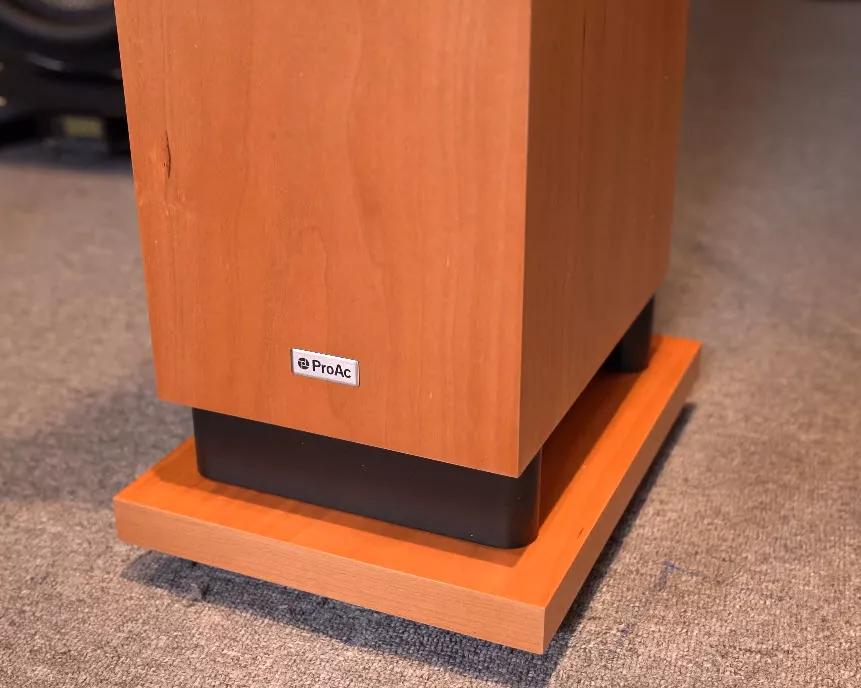
Associate the ProAc DT8 with electronics to the rich and extensive tonal palette, they will be expressed on all registers with softness, consistency, and a balance that will suit music lovers who favor delicacy and nuance in the playing of instruments. It is a listening characteristic that many manufacturers wish to achieve, a certain balance, without sanitizing the musical message and schematizing the inflections of music on all frequency registers.
As we were saying earlier, this is the first time that Proac has used different materials for the two membranes of the woofers, in a 2-way speaker. This fact influences the performance as we will study below.
While one is equipped with a cone in mica pulp, with very high performance in serious response, the other is equipped with a polypropylene cone offering a soft and detailed response in the medium.
The two speakers work in tandem allowing an ideal response from the extreme bass to the medium.
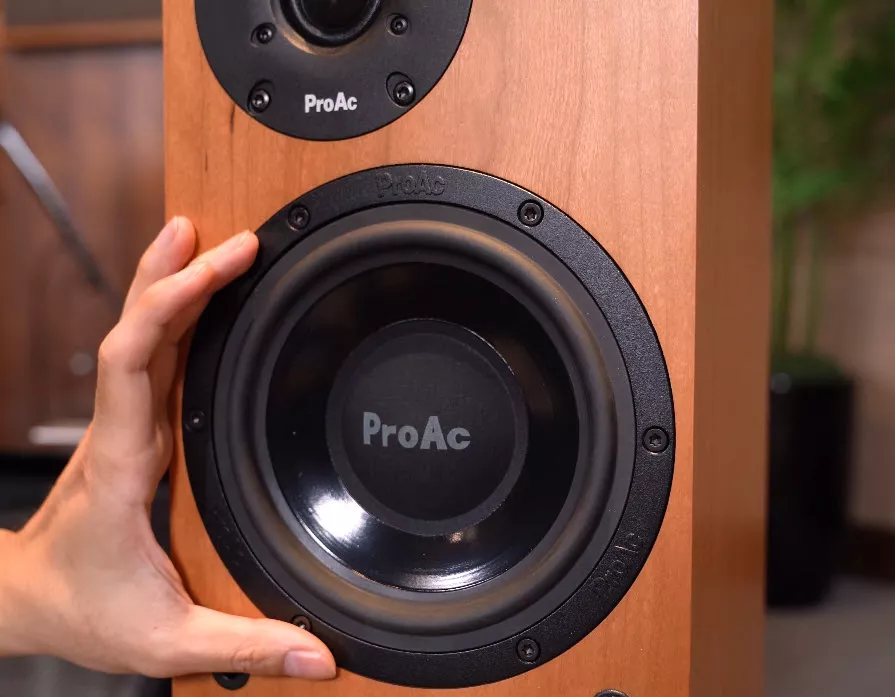
Unboxing
Since we are already in this topic, the installation of British columns in the system was pure pleasure. Apart from the visual aspect, this approach to the customer should be taught to many manufacturers of speaker sets from ProAc. After opening the hard cartons, I saw a large piece of white foam with a small notch in which a separate box with spikes was placed.
Then I turned the box upside down and slowly began to lift it up, looking at whether at this stage you would not need to, for example, detach the additional clamp from the sponge or remove the grilles that could fall to the side. Nothing like this happened.

However, I saw very hard cardboard beams, which additionally secured each of the corners of the box. Underneath, there were thick angles made of polystyrene. Like no big deal but after putting the cardboard aside, the columns stood in the middle of the room in a white cocoon. Beautiful work. Do you think you won’t care? Maybe not if you order equipment with installation, and qualified professionals will take care of the physical work. For many audiophiles, the moment of opening and connecting new equipment is a real children’s day.
Naturally, it should be a pleasure, but there are also situations in which a person wants to grab the phone, call the designer himself and tell him what he thinks about his ideas with cardboard boxes that literally tear in their hands, spikes stuck to the columns ordinary adhesive tape and plugs that cannot be removed without leaving visible scratches on the terminals.
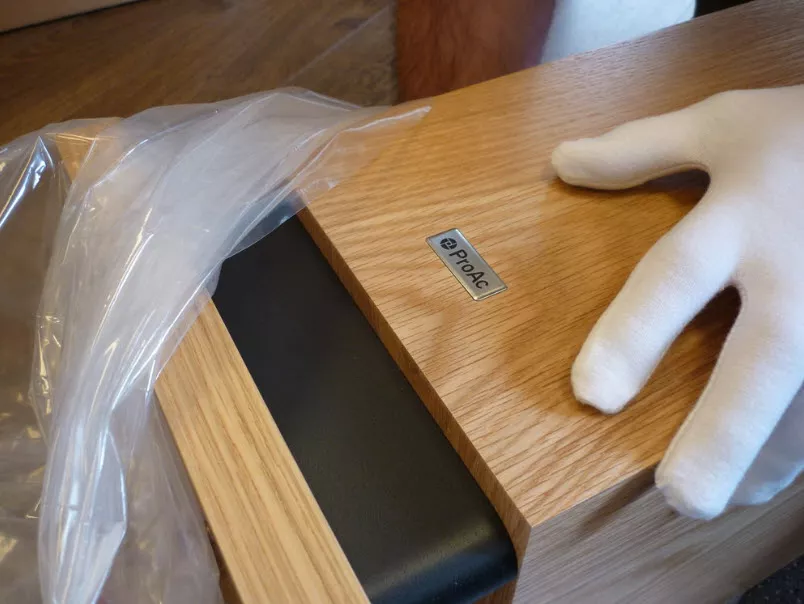
The columns themselves are slightly smaller than you might expect. The enclosures are less than a meter high, and so with spikes and, of course, stabilizing plinths, which are an integral part of the whole. It looks quite interesting because we are dealing with boxes that are separated from flat bases by two thick profiles with rounded edges – one near the front wall, the other at the back.
The two inches (five-centimeter) high separators are finished with a rough, black varnish, which looks particularly interesting in versions with light veneer.
Moving the plinth away from the proper housing was intended to ensure free airflow because it was here where the resonance tunnel outlet was located. The gently profiled bass-reflex blows towards the ground, which is not an unusual solution as it was a few years ago.
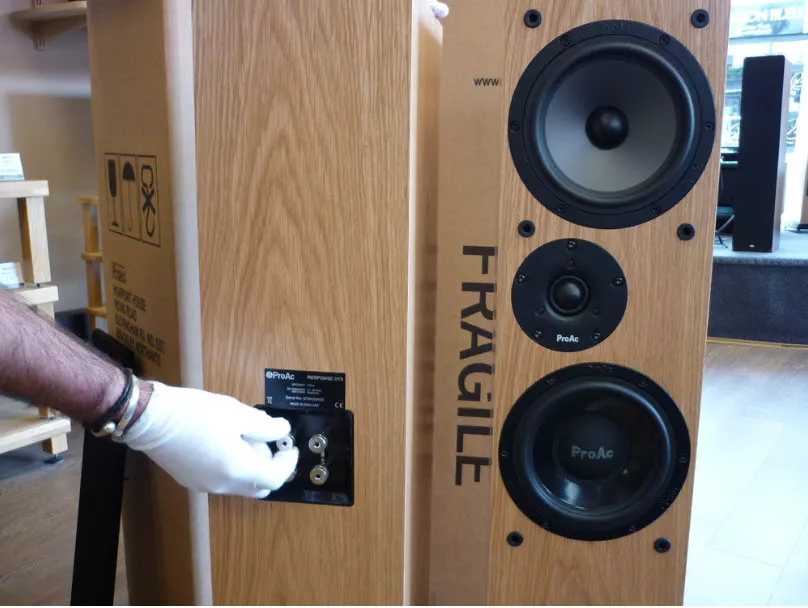
More and more companies are choosing them for various reasons, the most important of which seems to be greater freedom in placing loudspeakers in the listening room. Sets with a ventilation tunnel at the back should have a little space, but some music lovers can’t afford such extravagance.
In bass-reflex speakers theoretically, we can shorten this distance, but in practice, the elimination of one problem means the creation of two more. The first is the stereophony. We can forget about the holographic space with the speakers pushed to the very wall. The second problem is the type of ground and height, on which the bottom wall of our speakers will be located.
The floor blowing sets will play differently on a thick carpet than on an oak floor. Many companies leave this matter to us to work out on their own, but ProAc made sure that the way the reproduction of the bass is not a coincidence. The distance to the plinth established by the manufacturer does the trick.
It only has to be decided whether to set them on spikes or use a different solution, such as felt pads or other feet that can easily be screwed into threaded sleeves. A nice gesture from the manufacturer would be to attach a second set of legs to the set. Even metal “screws” with plastic or rubber endings would be enough for users to perfectly level each of the columns.
In good DIY stores, you will find wood joints with feet, available in versions with M6 or M8 thread.
There are many models on the market that are certainly more impressive in their shape, but if we evaluate each product also, or primarily based on what we can see and feel up close, we will have no reason to complain.
ProAc does a very good job, which can be seen even in the black version pictures. You can associate this black color with the Altus speakers from Tonsil (however newer Altus are coming in red too).
I immediately noticed the symmetrical drawing of the grain on the sidewalls, which in itself proves the manufacturer’s attention to detail. The same can be said about veneer joints on the edges and corners, as well as non-existent gaps between the transducer baskets and the front wall of the housing. And with a very small margin of error, because the mid-woofers cover almost the entire width of the front.
However, there are a few elements that may be important for the user. ProAc has placed tweeters between the mid-woofers, in addition “unbalanced”. So I would recommend doing a few tests and decide if we prefer the version with domes placed inwards or outwards.
Before starting critical listening, it would also be good to remove the grilles, which are attached with dowels and sit very tightly in them. During the test, I took them off very slowly, increasing the clearance in each of the three levels successively.
Thinking of alternatives to this, placing the tweeter between large speakers can, however, create a problem with finding a suitable listening position, and specifically sitting at such a height that we do not have to “look at the music” from above. In practice, however, this is not so troublesome, and I do not mean buying a low armchair, but the spatial experience counts.
I know that in a moment there will be ten specialists who will draw charts and start to prove that without 7 inches (18-cm) concrete slabs under the boxes we will get an incorrect dispersion and a very narrow sweet spot, but let’s not get crazy. True, here the tweeters are slightly over 28 inches (70 cm) above the floor and if someone likes to look at music “straight-ahead”, will have to stock up on a low seat. However, I also remember the Klipsch Heresy III 70th Anniversary Edition column test with knee-level tweeters. And they played great.
All right, enough for the unboxing and “first impressions”. Let´s go straight to talk about the design of the ProAc DT8 below. We have anticipated a few aspects of the design regarding the MTM layout chosen and the selection of the materials. Let´s dive in now…..
Design
Response ProAc DT8 is, in a sense, a special product, although it does not look like it at first. A column, like many others – one could say. Unusual, at least for ProAc, is the connection of belonging to the prestigious Response series and the price set at the level of the cheapest floor speakers from this brand – the withdrawn Studio 148 was only slightly cheaper.
This two-way floor column combines the latest technologies of the manufacturer. Two different 6.5 “membranes have been optimized to reproduce different frequencies. The whole is complemented by the tweeter, characteristic for ProAc, placed off the axis.
However, not only positioning is special, but also construction. Stewart Tyler decided on a very unusual and, what can be said, risky move. The speakers use three transducers in the MTM system (tweeter between two midwoofers). This type of speaker system can be made two-way (and often they are), but then you need to take care of the signal steep filtering (crossover design), so that below and above the axis no drastic “holes” in the characteristics.
The designer not only used a simple low order crossover but also used two completely different speakers. Both have identical diameters of seven inches (18 cm) and come from SEAS, but use completely different membranes. In the top speaker, it is made of thin polypropylene (the dust cover is so soft, that it bends from just looking at it firmly), in the bottom – polypropylene with an admixture of mica. It is also very soft, and the large dust cup seems almost openwork.
In addition, both speakers received completely different drives (the lower magnet is amazingly small). So we have two very different speakers working in a two-way system. Something that does not fit much at a glance.
I think that seeing these loudspeakers more than one recognized designer would tap on the head. So what was the idea behind Tyler? It is hard to guess, but the most likely hypothesis is that it was about obtaining the advantages of two-woofer speakers while maintaining a simple crossover design and that effects with two identical drivers did not give the desired results, he began to combine with different – in the hope that he would find such a combination speaker, in which both give good, masking their limitations.
On the basis of pure electroacoustics, this task seems breakneck, and yet the designer has achieved his goal, which results in the ProAc DT8 model.
After all, the loudspeakers are splendidly made. Yes, I know: they cost over 12,000 and are not large, so it is difficult for them to be poorly assembled. If you think so, then compare, for example, the precision of placing the speakers in the ProAc DT8 cutters with those for example in the ATC SCM40 or in the Super HL5 Plus Harbets (both of these columns are much more expensive). Everything is perfectly matched here. The veneer is very good quality, you can’t say a bad word. It is also impossible not to notice how heavy the loudspeakers are in relation to the dimensions. Almost 22 kg (50 pounds) with this volume is really a lot – and we add that the speaker’s input is negligible here.
So we look inside, and they are a familiar view: the walls lined with thick (about 5-mm or just over 3/16 inch) bituminous mats, on which stripes of polyurethane foam are laid. In this way, all the walls of the housing are lined, and it is worth adding that the rear (and probably also the front) are covered with veneer from the inside. The walls themselves are not thick (18 mm or just over 11/16 inch), and what’s more, no reinforcements were used inside. It can be seen that we are dealing with a completely different column design school than modern CAD tools and simulators suggest.
In the bottom wall, there is an outlet of a rather long BR tunnel. To ensure the necessary distance to the floor, high (52 mm) flat separators (pieces of MDF or medium-density fiberboard, a versatile wood substitute) were used to cover this gap when we look at the columns from the front or back.
We are not leaving completely the “Design” paragraph because we will see our findings regarding the structure of the cabinet, below.
Cabinet Structure
The cabinet set faithfully follows what could be defined as the golden rule of ProAc: tower furniture without internal reinforcements, bituminous panels with other thickness glued inside, speaker flanges in direct contact with the MDF (medium-density fiberboard) and filter components installed on the mass line.
Almost a line of thought, a business philosophy, other than construction techniques, not to mention the symmetrically installed off-axis tweeter! Yet in the ProAc DT8, we see the introduction of a small distortion as the two woofers connected in parallel with each other are quite different from each other but connected to the classic filter with a third-order cell on the tweeter and the second on the pair of woofers.
The execution is excellent with an impeccable level of finish. Particularly striking is the cleanliness and accuracy of the joints and details such as the large holes which, thanks to the larger flanges of the woofers, allow airflow in the rear of the speaker without obstacles and impediments. The interior of the cabinet is filled with highly effective sound-absorbing foam material.
Made from varying thicknesses of MDF (medium-density fiberboard), extensively braced, and then dampened with bitumen (an asphalt-like material), The ProAc DT8 cabinets are heavy and totally inert.
The tuned bass reflex port is fired downwards into the base plinth, managing the acoustic port function handily. This port arrangement makes the speaker very easy to place in the room because negative room/port interaction is minimized. The plinth is fitted with adjustable/removable spikes for isolation.
Each cabinet is covered with hand-selected sustainably harvested real wood veneer and handmade in the UK. They are then meticulously inspected at ProAc for any flaws before being hand-assembled by ProAc’s skilled technicians. The entire process is overseen by Stewart Tyler and his daughter, Zoe, making this truly a family affair!
Let´s go into more details of the cabinet structure because it is a nice topic to investigate in all ProAcs,
ProAc Response ProAc DT8, or just ProAc DT8, is a free-standing speaker system in a ventilated enclosure. The outlet of the resonance tunnel is on the bottom wall and is moved away from the stabilizing pedestals by about 5 cm (two inches) by means of two spacing beams. The base constructed in this way is to direct the air sideways, which according to the manufacturer reduces the bass boost resulting from the positioning of the speakers in the listening room.
It sounds a bit like English engineers have assumed in advance that ProAc DT8 Response users would not position them correctly if the bass-reflex was located somewhere else, but well … In some cases, they may be right. Audiophiles who are well aware of the importance of this issue, but do not always have the conditions to put their ideas into practice will also be grateful for such a solution.
The speakers use two 16.5 cm (6.5 inches) diameter mid-woofers and a one-inch (25-mm) textile dome mounted between them and off the axis, which gives us two possibilities of setting – with tweeters in or out. It seems that ProAc recommends the first option, but this does not mean that we are not allowed to carry out our own experiments.
The most interesting solution, however, is the use of two different woofers with the same diameter in a two-way configuration. Unlike 2.5-way designs, in which one of the transducers takes on a wider frequency range and the other helps it to pump low frequencies, here both units have exactly the same task. But at first glance, you can see that they are completely different.
The upper speaker – profiled to the middle of the band – has a polypropylene membrane, which, according to the manufacturer, reproduces sound without undesirable colorings. The lower woofer has been designed to reproduce low frequencies. Its membrane was made of mica mass and supplemented with a dust cap with the company logo. Both woofers were manufactured by SEAS, and in addition to membranes made of different materials, they also have other baskets and magnets.
The assumption was to connect two drivers with a slightly different sound character, but not to divide the band and not complicate the crossover, which here consists of six high-quality components. The idea is certainly interesting, but how much time was needed to stick both speakers “by ear” probably only Stewart Tyler knows.
The enclosures are made of 18 mm MDF and thoroughly damped with bituminous mats and pieces of polyurethane foam. Both materials adhere to the walls of the box so that nothing flies loose.
Interestingly, MDF boards were also covered with veneer from the inside, which probably was to improve their stiffness. It is not about the outer layer itself, but also about the process of applying it, during which the surface of the plate becomes harder. These are details that cannot be seen from the outside. However, you can see natural veneer available in several colors. At the basic price, we have a choice of black ash, mahogany, cherry, maple, and oak. You have to pay 700 dollars more for ebony and rosewood.
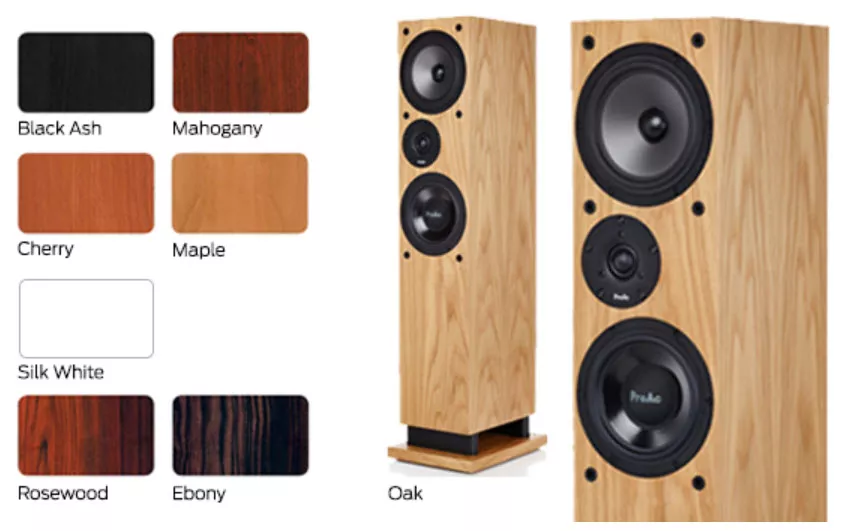
The walls of the cabinet use different thicknesses of MDF to best diffuse the resonances. They are also reinforced and damped to give drivers a solid and silent base to work on. To the advantage of an ideal combination with the home environment, there are five standard finishing options (black ash, maple, mahogany, oak, and cherry), while, as already mentioned, the premium ebony and rosewood ones increase the price of almost 700 dollars. I did not even see these premium colors, so I cannot tell you how do they look like.
Due to the pairing of the columns for an identical wood pattern, ProAc DT8 comes to us as a set. On stabilizing plinths, right next to the bushes used to screw in the spikes, we will find stamped numbers “1” and “2”. On the back, there is only a rating plate and double, rhodium-plated sockets with the company name imprinted.
When it comes to parameters, the loudspeakers are characterized by 90 dB efficiency and 4-ohm nominal impedance. More on this, later below.
On its website, the manufacturer recommends using amplifiers with a power of 20-180 W, but the columns have a range of 10-180 W. Let’s think that this version is correct, although I have a lot of doubt whether going down to such a low level is a good idea. The frequency range declared by the manufacturer is 38 Hz – 30 kHz. A single column weighs 26 kg. rhodium plated sockets with the company name imprinted very visibly.
However, we have some criticism to make. The use of two types of 16.5 cm mid / bass drivers operating in tandem can be intelligent from an engineering point of view, but visually it may not be very nice.
It seems strange and the same goes for the ProAc logo printed directly on the mid-woofer (choice in our opinion questionable on the aesthetic side), on the tweeter, and on the base of the speakers. In short, everything is slightly redundant, but otherwise, we have no complaints about the construction of these speakers, as we would have expected from ProAc. The 39-inch (98 cm) high cabinet is decidedly solid and has clear edges and a well-applied wood veneer.
Coming back to the utilization of two types of mid-bass drivers. In technical terms, in a driver of this type, there is always a compromise between the optimization of the middle range and that of the bass and usually, the designers end up adopting a solution that best suits the product.
By using different drivers working in tandem, ProAc engineers have tried to get the best of both worlds. A polypropylene cone in the upper part takes care of the mids, while a rigid diaphragm of mica paste in the lower part returns powerful but articulated bass. The trick is to make the two work smoothly, which is not an easy challenge but ProAc succeeded here.
Specifications
We never just copy and paste the specifications broadcasted to us by the manufacturer I the press release. We will just describe the most important specifications that we consider are useful for you to know.
The most important features:
- Two-way bass-reflex construction with a tunnel outlet in the base
- Two different 6.5 “speakers specializing in different acoustic bands
- Proven off-axis ProAc tweeter
- 90dB efficiency
- 38Hz-30kHz frequency response
- Nominal impedance: 4 ohms
- Recommended amplifiers: 20 to 180 watts
- Frequency response: 38 Hz to 30 kHz
- Sensitivity: 90dB linear for 1 Watt at 1-meter distance (40 inches)
- Low/middle: 2x 6.5-inch units with different cone material
- Tweeter: Exclusive to ProAc 25mm soft silk dome, air-cooled and heavy-duty internal cushioning
- Crossover: special crossover designed for 2 different mid/bass units
- Dimensions: 978 mm high, 193 mm wide, 229 mm deep
- Weight: 24 kg each
- Model: Floor standing
ProAc Response ProAc DT8 floor standing speakers are a two-way bass-reflex construction. Its outlet is directed downwards, and a specially designed base directs the air sideways. This reduces the bass boosts caused by the speaker setting.
Sound
In my test in the store, where we have installed the columns, we placed the Response ProAc DT8 approximately one meter away (40 inches) from the front walls and rather far from the side walls.
In addition, we have angled them slightly towards the listening position to better focus the stereo image. It is not mandatory that you angle them like that at home, but it is a good recommendation to place them far from the sidewalls.
At first glance, the new ProAc DT8 seems to play familiar – this is a pleasant, well-arranged sound that we know from many ProAc designs.
Almost immediately, however, there are some differences: a strong midbass, noticeable weakness at the turn of the midrange and treble, and they seem to shine more than usual – even in the Studio SM100. The tonal balance is still shifted down, but there is plenty of trebles.
When an artist sings, when they play instruments, they give the impression that they want to enter our room.
To appreciate it well, you have to be sitting at the optimal height. Attention should be paid to this aspect – the vertical dispersion is clearly weak and you really need to sit in a low chair (the tweeter is only 72 cm from the floor) to get the optimum of what these speakers can do.
As a short excursus, let´s remember how dispersion works here. Dispersion occurs horizontally, vertically, and every which way in between, but speaker designers are generally most concerned with horizontal dispersion. This is because a seated listener’s ears will typically be about at the same level as the speaker’s tweeter, so they’ll be on roughly the same vertical axis.
I immediately appreciated the very important advantage of these speakers: lightness, airiness of the sound – despite the strong midbass, which seems to “hook” a little on the low midrange. This effect is in a way due to the great quality of the treble: smooth, vibrant, and detailed. The veiling effect is minimal and typical for soft domes – nothing more. For a better vertical dispersion, we have the Devialet speakers in this review: the Gold and the Silver.
So looking at the ProAc DT8, we have a larger cabinet and two mid-woofers, but it’s still a two-way system, and the membrane sizes aren’t amazing .
Already the first minutes of listening confirmed my previous experience with sets from this brand. I know that British monitors have many fans, but I probably would not be able to give up the advantages of floor ProAc s, even if their purchase would involve a large surcharge. Meanwhile, I look at the distributor’s website and I can’t believe my eyes. Response DB1 is just a bit cheaper. However, Response D Two costs more than the tested ProAc DT8, also from the Response product family! I assume that there must be a method in this madness. But what? I do not have a clue.
The reason is very simple. Most of the speakers from this brand have something very cool about them. Something that lies mainly in the way of reproducing medium tones, but not only. Their sound is very natural and organic. You don’t have to get used to it. It is like an old, very comfortable armchair.
ProAc DT8 are columns with character. It does not only result from what happens in the midrange. Yes, we observe here the density and warming typical for many British sets combined with a certain exposure of vocals, but the list of interesting elements does not end there. The bass itself is interesting. I have the impression that the designer was not only about extending the bandwidth down while maintaining the same character of the presentation but about building something here that will attract the attention of listeners as well as medium and high tones.
Response ProAc DT8, or ProAc DT8, can venture low, but they do not attach much importance to typical subwoofer frequencies. Real driving starts a bit higher in the mid-bass range. Suddenly, the whole flesh comes to light, what these two complementary woofers can show us. As a result, we get very strong, energetic, springy, and saturated bass. I have no doubt that it is not perfectly equal. Some would prefer to cut some mid-bass in exchange for a slightly better descent at the very edge of the band.
The characteristic bass also influences our perception of midrange. The relations between these ranges are very interesting. During the test, sometimes I felt as if the columns were showing me my favorite albums from a slightly different perspective. Not from the side and upside down, but from a slightly different angle.
Sometimes the vocals had more mass than usual, and at other times the low tones suddenly accelerated, giving the sound more movement. Not knowing why I listened fantastic to those jazz columns that I normally don’t like. The heavier genres based on the dense sound of electric guitars also came out sensational. The ProAc DT8 showed that despite the light density and warming of the presentation, they can play very energetically, with a decent kick and a very clear low-midrange range. Classics? Yes, here you can also notice something interesting. The piano can stand much closer than we would expect. Contact with this majestic instrument in this release takes on a very direct, even intimate dimension.
Impedance and electric phase
With a nominal impedance of 4 Ohms and a sensitivity of 90 dB, there should be no problem reaching high volume levels with most amplifiers that should be considered for speakers of this level.As per ProAc tradition, here too we find the bass loaded through the side vents, a configuration that makes the speakers less demanding regarding positioning in the room compared to traditional alternatives.
One thing is even striking when looking at both (superimposed blue and black) charts of the impedance module. Despite the fairly good resolution of the charts (and thin lines), both almost perfectly match each other.
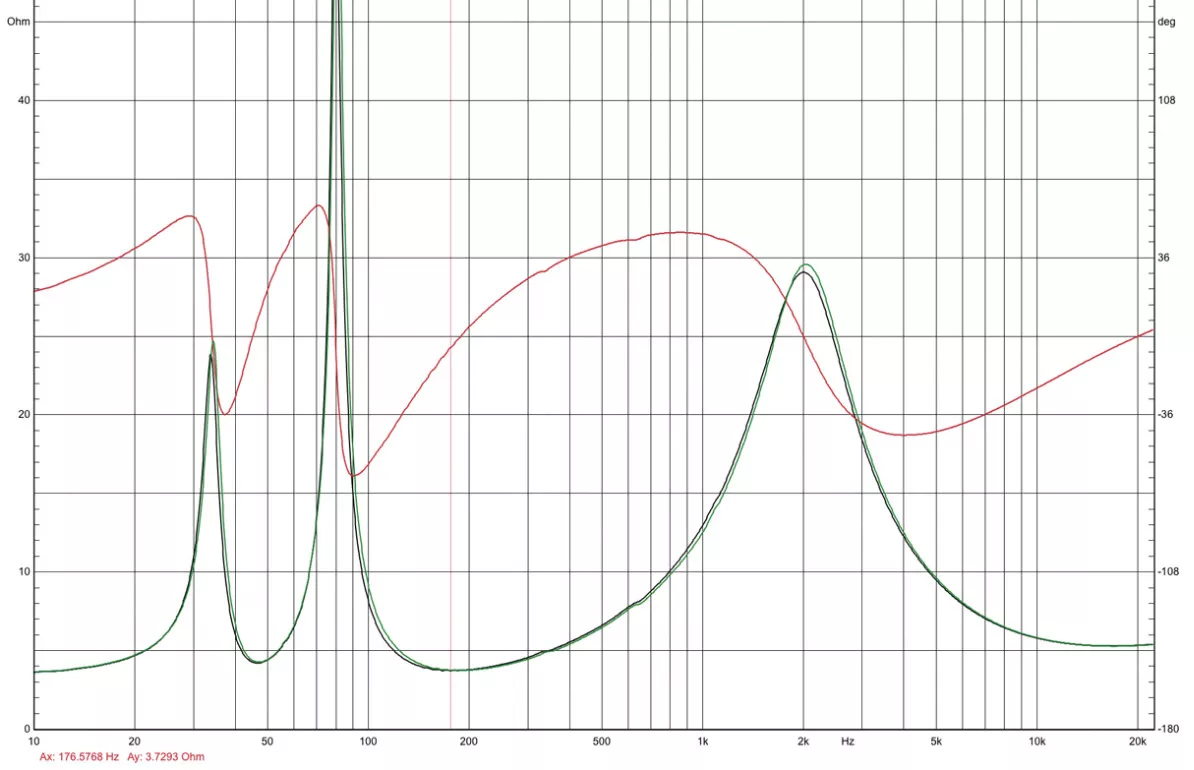
This demonstrates the extremely narrow pairing tolerance of transducers and crossover components and high repeatability of enclosures. So far, we have seen an “almost” equally good result only for the Magico S5 MkII loudspeakers. However, let’s pay attention to the word “almost” and the price – over 15 times higher.
Of course, the fact that the left and right channel electrical convergence do not result in obvious benefits for the quality of the sound, but the fact – or rather not the case – is the best proof of the manufacturer’s diligence.
ProAc DT8 turns out to be quite a typical 4-ohm load, with characteristic for bass-reflex two local minima within the bass, of which the lower (at 36 Hz) corresponds to the frequency of tuning the resonance system. This is a small value in the context of the type of speakers used (their resonance frequencies are higher).
The value of the impedance module drops to 3.3 ohms at around 140 Hz, which is a low value, but not disturbing in the context of the capabilities of modern amplifiers. Maximum phase angles do not exceed +50 and -53 degrees.
Considering the high efficiency of the loudspeakers, the tested ProAc DT8 can be considered as not demanding for the amplifier. Go ahead and try with tube amplifiers at least 20-30 W per channel.
About ProAc And ProAc DT8
There are few producers of loudspeakers or hi-fi equipment in general who would survive the almost 40-year test of time without bankruptcy, ownership changes, acquisitions, buyouts, buy-outs, etc.
What decided about the longevity of the ProAc brand led by Stewart Tyler – a man quite secretive, which is not particularly popular at exhibitions or shows. In general, it must be said that ProAc is a company standing as if out of the way. This company has neither been hungry for marketing success nor has never often been at the forefront of audio magazines.
ProAc seems to be one of those brands whose products customers are looking for, not the other way around. A good test of ProAc’s perception are opinions expressed in various discussion groups.
Trolls hating this brand are less than average. On the one hand, this may indicate its low popularity, but on the other, it also shows the respect it has. I bet on the latter.
Because ProAc is … the same as 20 years ago. Similar, still angular enclosures, no high-tech loudspeakers, attachment to classic materials, but also exemplary workmanship, very nice veneers and … this predictability – that if ProAc makes a loudspeaker, it rarely turns out to be unsuccessful. To some extent, it resembles another British brand: Harbetha. Both are of a similar age and both remain faithful to the solutions they developed many years ago.
Conclusions For The ProAC DT8 Review
Interesting speaker set. It seems that they arose from the need to offer a more dynamic design than Studio 148, but at the same time equally sophisticated. It is also hard to deny that the ProAc DT8 design includes some sound specificity derived from an unusual solution.
Although I don’t like sound combinations, I have to admit I liked these speakers. They have evident ProAc genes, i.e. a lot of sublimation, a very good sound stage, and generally well-saturated “colors” (albeit somewhat coloring vocals and more). Therefore, it is worth to include them on the “list” if you are looking for columns from this price range.
Far from stereotypical speakers and attractive design, a ProAc remains a ProAc. Sober look, almost discreet, small size and roomier but with a significant weight, flawless finish.
Further Readings
We have some other interesting articles for you to read, we have selected our top articles below, and tried to keep this list short.
We have a technical vademecum where we discuss industry terminology and how it can be useful for you. Selected examples are the definition of PCM audio, then comes the comparison between PCM and Bitstream, the comparison between DTS Neo 2.5 and Dolby Digital, and the process to match amplifiers to speakers.
Also, we have reviewed some interesting DAC: The Elgar Plus from dCS, and the Schiit stack. where the Modi 3 behaves as an entry-level DAC.
In our reviews of AV receivers, we can recommend you to read some of our favorites, the ones that we liked the most, and trying to make the list short, we have the Denon AVR-X2500H, the Onkyo TX-NR686. We also have reviewed completely the Denon 8K receivers where we have studied the 8K Denon AVR-X2700H, the Denon AVC-X6700H, the AVC-X4700H, and the AVC-X3700H.
If you are into amplifiers, my favorite is the McIntosh MA9000, and that is why I would like to recommend you to read that review. My second favorite amplifier is the Mark Levinson 5805.
Regarding speakers, we have reviewed tiny bookshelf-speaker devices to large towers. My favorites were: the Devialet Gold, the Devialet Silver, the ProAc Response DT8, the Bowers and Wilkins 805 D3,
We do not review many headphones, but if you want a Sennheiser headphone for less than 100 dollars, we have this Sennheiser HD595 review.
We have some TV and monitor reviews and here we recommend the Samsung NU8000 (for gamers!) and my favorite is the review of the classical Pioneer Kuro.
Our home theater aficionados want to know everything about video definitions and configurations. So we studied 720p, how to scale it to 1080p the right way, and compared 1080p with 1440p and demonstrated why 1440p is not always better. Likewise, we had the urge to compare 1440k with 4K and try to find out how much are we gaining with the change.

I am Bob. I work as an audio engineer and audio technician. I work in mastering and arranging bridges in existing songs and the arrangement and orchestration of the chorus. In Planet HiFi I test gear for a couple of days and write a review. I also write about AV topics, amplifiers, speakers, and headphones.

